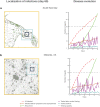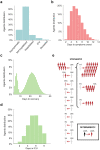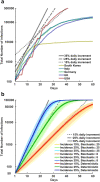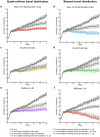Containment of COVID-19: Simulating the impact of different policies and testing capacities for contact tracing, testing, and isolation
- PMID: 33788852
- PMCID: PMC8011755
- DOI: 10.1371/journal.pone.0247614
Containment of COVID-19: Simulating the impact of different policies and testing capacities for contact tracing, testing, and isolation
Abstract
Efficient contact tracing and testing are fundamental tools to contain the transmission of SARS-CoV-2. We used multi-agent simulations to estimate the daily testing capacity required to find and isolate a number of infected agents sufficient to break the chain of transmission of SARS-CoV-2, so decreasing the risk of new waves of infections. Depending on the non-pharmaceutical mitigation policies in place, the size of secondary infection clusters allowed or the percentage of asymptomatic and paucisymptomatic (i.e., subclinical) infections, we estimated that the daily testing capacity required to contain the disease varies between 0.7 and 9.1 tests per thousand agents in the population. However, we also found that if contact tracing and testing efficacy dropped below 60% (e.g. due to false negatives or reduced tracing capability), the number of new daily infections did not always decrease and could even increase exponentially, irrespective of the testing capacity. Under these conditions, we show that population-level information about geographical distribution and travel behaviour could inform sampling policies to aid a successful containment, while avoiding concerns about government-controlled mass surveillance.
Conflict of interest statement
The authors have declared that no competing interests exist.
Figures






Update of
-
Containment of future waves of COVID-19: simulating the impact of different policies and testing capacities for contact tracing, testing, and isolation.medRxiv [Preprint]. 2020 Jun 7:2020.06.05.20123372. doi: 10.1101/2020.06.05.20123372. medRxiv. 2020. Update in: PLoS One. 2021 Mar 31;16(3):e0247614. doi: 10.1371/journal.pone.0247614. PMID: 32577688 Free PMC article. Updated. Preprint.
References
-
- World Health Organization (2020) Novel Coronavirus (2019-nCoV) Situation Report– 1, Data as reported by: 20 January 2020.
-
- World Health Organization (2020) Weekly epidemiological update—1 December 2020.
-
- European Centre for Disease Prevention and Control (2020) Coronavirus disease 2019 (COVID-19) in the EU/EEA and the UK–tenth update, 11 June 2020. Stockholm: ECDC.
-
- European Centre for Disease Prevention and Control (2020) Coronavirus disease 2019 (COVID-19) in the EU/EEA and the UK–eleventh update, 10 August 2020. Stockholm: ECDC.
-
- World Health Organization (2020) Draft landscape of COVID-19 candidate vaccines—2 December 2020.
Publication types
MeSH terms
Grants and funding
LinkOut - more resources
Full Text Sources
Other Literature Sources
Medical
Miscellaneous

